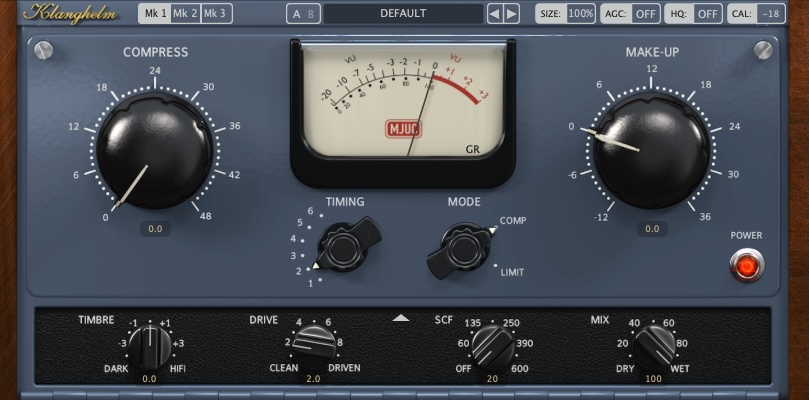
Klanghelm MJUC on the Vocal Bus: Vari-Mu Glue, Density & Polish
Tansel Günay (aka Punkat) — Punkat Music Sàrls | Steinsel/LUXEMBOURG

On my vocal bus, MJUC is a fixture: it gives me musical levelling, tube-like density and a natural sense of forwardness without harshness. MJUC offers three models (Mk1/Mk2/Mk3) with different program behaviours, a sidechain HPF, DRIVE saturation, Mix for parallel, TIMBRE tilt, and smart metering modes.
Quick Summary
- Mk1: early vari-mu vibe; gentle, vibey levelling. Timing 1–6 ranges from fast/fast to program-dependent long.
- Mk2: more forward; program-dependent attack (~0.8–35 ms) and recovery (~20 ms–3.6 s), optional 2nd tube stage, interstage transformer.
- Mk3: modern, punchy; program-dependent attack (~0.4–35 ms), recovery (~20 ms–3.6 s), extra punch slider, 2nd tube stage & transformer.
- Workflow: hit ~0 dBVU in, set Compression, then Make-Up. AGC recalculates with GR-affecting changes (avoid during automation).
Controls that Matter on a Vocal Bus
Sidechain HPF
Rolls low-end out of the detector to avoid chest-boomy triggering; perfect for proximity-heavy takes.
DRIVE & TIMBRE
DRIVE adds tube-ish saturation (set CLEAN to disable for CPU savings). TIMBRE tilts global tone (−5 dark, +5 “hifi” smile).
Transformer & Twin Stage
Interstage transformer cleans up and clarifies compression; second vari-mu stage yields denser GR (Mk2/Mk3).
Channel Modes & Mix
MONO/STEREO/DUAL MONO behaviour per channel; built-in Mix for instant parallel blends.
My Go-To Vocal Bus Recipes
1) Pop Lead: upfront, silky
- Model: Mk2 • SC-HPF: 80–120 Hz • Compression: set for 1–2 dB avg GR
- Options: Transformer On, 2nd Stage Off, Timbre: +1 to +2
- Mix: 80–90% • Drive: subtle (just to wake the harmonics)
- Why: program-dependent attack/release rides syllables musically without spitting.
2) R&B Ballad: warm levelling
- Model: Mk1 • Timing: 3–5 (slower release, program-dependent variants)
- SC-HPF: 100 Hz • GR: kisses 2–3 dB on peaks
- Timbre: 0 to −1 (round mids) • Mix: 100%
- Why: early vari-mu smoothness; natural bloom and phrase glue.
3) Aggressive EDM Topline: controlled & bright
- Model: Mk3 • Punch Slider: to the right (avoid LF distortion at fast times)
- Attack/Recovery: let program-dependent do the work; aim 1–2 dB avg GR
- SC-HPF: 120–150 Hz • Mix: 70–85%
- Why: Mk3’s modern engine stays punchy and clean at fast constants.
4) Jazz/Acoustic Ensemble Vox: invisible rider
- Model: Mk1 or Mk2 • Timing: 4–6 (long/program-dependent)
- Transformer: On • 2nd Stage: Off
- GR: peaks 1–2 dB • Timbre: −1 (de-glare)
- Why: “breathing” release preserves micro-dynamics & stage depth.
Advanced Tips & Troubleshooting
Dual-Mono for Width
On doubled vocals, try DUAL MONO so L/R breathe independently; watch center image stability.
Auto-Makeup & Automation
AGC recalculates with GR-affecting moves—disable during automation to avoid jumps; then trim with Make-Up.
Metering & CAL
Switch VU to IN/OUT/GR/OUT-IN (ΔRMS) and set CAL for true reference across the path.
Clean vs Color
Set DRIVE = CLEAN to audition pure compression (and save CPU), then re-introduce drive/timbre tastefully.
Closing Notes
MJUC is a true “set-and-listen” vari-mu. Mk1/Mk2/Mk3 cover everything from soft levelling to modern, punchy control. With SC-HPF, transformer/twin-stage options and parallel Mix, it earns a permanent spot on my vocal bus.